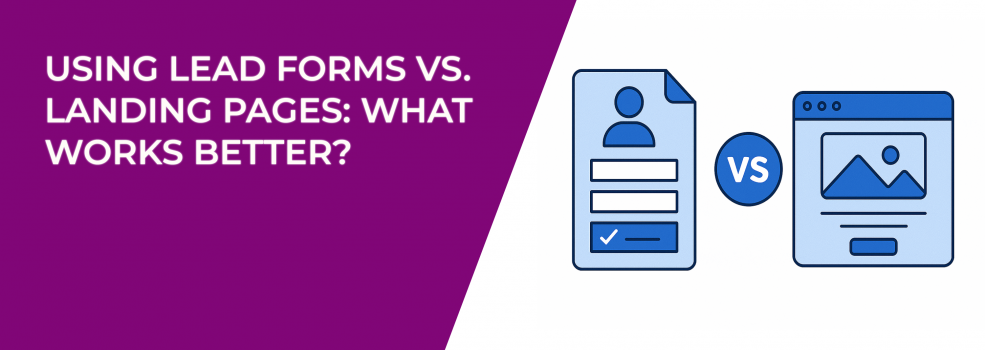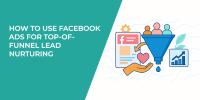You’ve planned your campaign. Targeting is dialed in, the creative is solid, and your offer is ready to go. But there’s one decision that often gets overlooked — and it could significantly impact your results.
Should you drive users to a native lead form or a dedicated landing page?
Both options can generate leads. But they do so in very different ways, with different implications for cost, quality, and long-term value. Choosing the right path isn’t always obvious — especially when the pressure is on to deliver performance quickly.
Let’s take a closer look at how lead forms and landing pages stack up, and how to make the right choice based on your goals.
What’s the Difference Between Lead Forms and Landing Pages?
At a glance, the two seem similar — both are designed to collect information and convert interest into action. But the experience for the user (and the outcomes for the advertiser) can be very different.
Lead forms, such as Facebook’s Instant Forms, open directly within the platform. They’re mobile-optimized, fast-loading, and typically pre-fill with user data. This reduces friction and makes it incredibly easy for users to submit.
Landing pages, in contrast, take users outside of Facebook or Instagram to a separate web page. These pages can be custom-built, fully branded, and structured to include more detailed content, visuals, testimonials, and call-to-action elements.
So which one performs better? The answer often depends on the context and on what “performance” means for your business.
To decide whether lead generation ads or conversion campaigns align better with your goal, check out our breakdown of lead generation ads vs. conversion campaigns first.
Lead Forms: Frictionless and Scalable, But With Trade-Offs
Lead forms are designed for speed. A user sees your ad, taps once or twice, and they’ve submitted their information. It’s a low-effort experience — and that’s precisely the point.
This simplicity makes lead forms ideal for campaigns focused on volume. If your goal is to fill the top of the funnel quickly — say, for a giveaway, newsletter signup, or free quote — lead forms can deliver results efficiently.
However, there’s a common downside: lead quality can suffer.
When submission takes just seconds, users may act out of curiosity rather than genuine interest. That can lead to high numbers but low engagement post-submission — especially for offers that require commitment or follow-up.
Tips for making lead forms more effective:
-
Include a qualifying question or two to filter out low-intent users.
-
Be explicit in your ad copy about what the user can expect next.
-
Use strong, benefit-focused headlines in the form itself.
-
Avoid overloading the form — 3 to 5 fields is usually sufficient.
Lead forms are a strong option when your audience is familiar with your brand or when the offer is simple and straightforward. But for complex services or high-ticket products, they often don’t provide enough space to build trust or context.
Landing Pages: More Control, Higher Intent
Landing pages take more effort — both from the advertiser and the user. But that added friction can work in your favor.
When someone clicks your ad and stays engaged through a full landing page, it’s a stronger indicator of interest and intent. You have more room to explain your offer, provide reassurance, and present compelling proof points that increase conversion readiness.
This makes landing pages well-suited for mid- to bottom-of-funnel campaigns — such as consultations, demo requests, or product launches. When trust matters, or when your offer isn’t easily explained in a few words, a landing page gives you the necessary space.
Best practices for effective landing pages:
-
Match the messaging and visuals of your ad to the page content.
-
Prioritize mobile responsiveness and load speed — even a short delay can cost you.
-
Focus on one clear CTA. Avoid distractions or competing offers.
-
Use trust elements like testimonials, logos, or guarantees early on the page.
Another key benefit? You own the data. With landing pages, you can track user behavior more closely, optimize performance through A/B testing, and use advanced analytics to refine your funnel.
Lead Form or Landing Page: Which Should You Choose?
There’s no universal answer — and that’s a good thing. It means you have flexibility, depending on what your business needs at a given moment.
Here’s a general guideline:
-
Choose lead forms when you're optimizing for volume, running time-sensitive campaigns, or targeting colder audiences.
-
Choose landing pages when you need to educate, qualify, or persuade — especially with higher-value or more complex offers.
But rather than relying on assumptions, the most effective advertisers test both.
Run parallel campaigns. Use the same targeting, budget, and creative, but direct users to different destinations. Then compare the data: CPL, conversion quality, downstream sales, and user engagement.
You may find that lead forms bring more contacts, but landing pages convert more paying customers. Or that different segments respond better to different formats. The insights you gain from testing can directly improve your long-term ad performance.
If you’re collecting leads but struggling to turn them into actual customers, it’s worth exploring why your Facebook ads aren’t generating leads and how to fix it.
Final Thoughts: Be Flexible, Stay Strategic
The digital advertising landscape is evolving quickl, and so are user expectations. That means the right answer today might not be the best option six months from now.
Rather than choosing one format and sticking with it indefinitely, take a strategic approach. Let your campaign objective, audience intent, and offer complexity guide your decision.
Ask yourself:
-
Is my goal awareness, lead volume, or qualified conversions?
-
How much context does my offer require?
-
Is my audience already familiar with my brand?
By aligning your lead capture method with your campaign goals you’ll be in a much better position to drive consistent results. And if lead generation is your core focus this year, don’t miss our guide to mastering lead generation in 2025 packed with actionable tactics.

